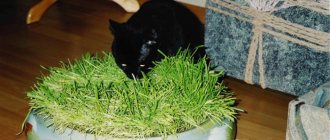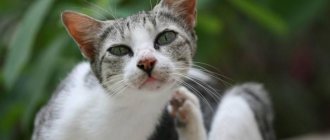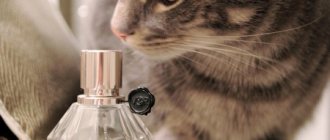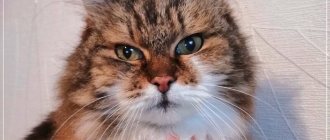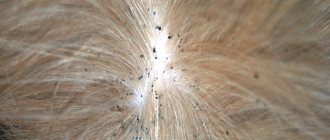Cat breeds with big ears have a wild appearance that reflects their origins in big cats, and this unique trait is making domestic cats with big ears more popular than ever. In the wild, these huge ears serve an important function, allowing the cat to hear even the smallest sounds while hunting for prey.
There are many aspects to cats that make them adorable pets: their soft fur, long tail, and of course, their all-knowing eyes. But perhaps at the top of the list are their ears, and the bigger they are, the cuter they are. We've compiled this list of 12 cat breeds with big ears so you can see them in all their adorable glory!
Siamese cat
© shutterstock
The Siamese cat is one of the most recognizable Asian cat breeds and one of several breeds found in Thailand. They are long, slender and elegant cats with sleek coats that are usually a mixture of chocolate, cream and black. The Siamese cat is smart and very affectionate with its owner. With such long and slender legs, body and tail, it is no wonder that the ears appear even larger than they really are!
Kanaani
And another pet with an extremely expressive wild appearance and large ears. Kanaani is an animal with a powerful body and a bright leopard color. He is fully socialized to be kept indoors and to live with people.
Like any other domestic cat, this small leopard needs periodic water treatments and vaccinations. Perhaps the only thing potential Kanaani owners should know about is the need for walks in the fresh air. This cat will happily walk on a leash and explore its surroundings with curiosity.
Kanaani has a special character. They:
- freedom-loving;
- have serious hunting skills;
- flexible;
- loyal.
However, finding a common language with her is quite difficult. But, as practice shows, patient and loving owners still manage to turn this rather wayward animal into an affectionate pet and a reliable friend.
Kanaani are attracted by their unpretentiousness in nutrition and care
So how can we give up a cat with big ears now? Moreover, the choice is more than great. Among these beauties there are wild, wayward natures, and those who are ready to become your most devoted friend.
Sphinx
© shutterstock
The Sphynx breed is most widely known for its fur—or shall we say, lack thereof! Hairless cats usually have large ears, and the Sphynx is no different. Lack of hair in cats is usually the result of a natural genetic mutation, but Sphynx cats have been selectively bred to be hairless. These cats are highly sought after, which is why they are rare and expensive, and their large ears make them a unique and attractive cat breed.
How to choose?
When choosing a big-eared kitten, you should focus both on its appearance (many, for example, cannot stand the sight of cats without fur or are not ready to put up with the shedding of the Turkish Angora), and on its character traits
Families with children should be careful when choosing representatives of breeds such as Savannah, as these cats can be very active and even aggressive. The same applies to Siamese cats, in which the “call of the wild ancestors” periodically awakens, and they can, for no apparent reason, bite or rush at a person, even if this is an adored owner
It is imperative to take into account the size of the cat and relate it to the size of your home. Will an active pet, such as an Abyssinian cat or a Serengeti cat, have the opportunity to run and climb to its heart's content? Will the Havana or Angora have enough horizontal surfaces to allow them to spread out gracefully? Are you ready to keep the windows closed at all times so that your beloved Sphynx does not catch a cold or sneeze? Will you be able to calmly accept the manifestations of the Siamese’s irrepressible temperament?
Think carefully about all the issues before purchasing a kitten, because most of them are not cheap. When buying a pet, make sure that he is comfortable with you, but you should not live in constant restrictions.
You need to find a cat so that both she and you are happy with your life together.
Cornish Rex
© shutterstock
The Cornish Rex, a breed of domestic cat often called a "greyhound", has a unique coat among cat breeds. Their fur is short, soft and silky, forms waves along the body and consists almost exclusively of undercoat. This soft, curly coat is prone to shedding, and these cats eventually lose most, if not all, of their fur.
Ukrainian Levkoy
Another descendant of the sphinxes. This is a hairless cat with an elongated body, graceful and agile. This mug should be counted among the “eared ones”, if only because of the presence of a cute fold of ears. The ears are large, located high on the top of the head, set apart. A third of the auricle is lowered down. Sometimes there are cats with erect ears.
Levkoi have a flexible character. They are not inclined to be mischievous and do not remember evil. All this hairless cat needs is warmth and pleasant human company. Like all descendants of sphinxes, Levkoy does not like loneliness.
Ukrainian Levkoy
Levys are a bit spoiled when it comes to caring for them. This is due to their nature. The cat must be regularly wiped with warm water, and the condition of its skin must be monitored. Any irritation and peeling require lotion and creams.
Otherwise, these Murki do not differ from ordinary immigrants from the east. They are smart, friendly and do not like to be alone.
Devon Rex
© shutterstock
The Curly Cornish Rex's cousin, the Devon Rex, is similar in appearance, but their coat is caused by a different genetic mutation, making them a completely different breed. They are often called "alien" cats due to their unique appearance, which is highlighted by their huge, rounded ears that sit uniquely low on their heads. Another unique feature is their whiskers, which are so short and curled that they often appear to have none.
Velvet
Cornish Rex
A refined figure, short curly hair and beautiful large ears - by these signs you can recognize the representative of the Cornish Rex. In some places the fur is so short that the silhouette of the cat can be mistaken for a Sphinx. The advantage of this breed is that they practically do not shed, that is, they do not need to be combed or washed in any way. Features of care:
- Large ears require weekly cleaning.
- The paws of these cats are designed in such a way that they cannot hide their claws in the pads, so the claws also need to be trimmed often.
The character of the Cornish Rex is rather intelligent, they are well-mannered, keep themselves and their sleeping place clean and never go past the litter box.
Canadian Sphynx
These cats with more than extraordinary appearance managed to win the hearts of a huge number of people. Sphynx cats have a somewhat rounded body with a wide chest and round belly. The front legs are set wide apart and their tail is long and thin. The well-defined muzzle has prominent whiskers, expressive lemon-shaped eyes and very large, wide-set ears with rounded tips. They have smooth skin with numerous folds on the forehead, neck and limbs, while the body can be completely bald or have the finest, almost invisible fluff.
But not every hairless cat will be a Sphynx. Representatives of this breed have exceptionally soft outlines and a magical appearance. There are no straight lines in the figure, everything is rounded and convex, and the lines are only fluid and smooth.
The character of the Canadian Sphynx is also captivating. These pets usually:
- good-natured;
- peaceful;
- are not afraid of dogs;
- easy to train;
- very attached to people.
The Canadian Sphynx is a cat with a naked hot body and a special character
Eastern cat
© shutterstock
Both shorthaired and longhaired Oriental cats have characteristically long ears and are closely related to Siamese cats. They are social, playful and often vocal cats, characteristics they share with their Siamese cousins. The main difference is their coat, which can come in a variety of colors and patterns. Their genetic roots are in Thailand, and since then the breed has become one of the most popular among members of the Cat Fanciers' Association.
Balinese cat
© shutterstock
With their sapphire blue eyes and distinctive dotted coloration, Balinese have much in common with their close relatives, the Siamese. Indeed, the Balinese are widely known as purebred longhaired Siamese, as they originated as a natural mutation of the breed, with the only real differences being their longer coat and bushy tail.
They were originally known as Longhaired Siamese cats, but the original breeders felt that this was too verbose and subsequently shortened the name to Balinese.
Animal hygiene
The Scottish Fold cat is considered one of the least problematic breeds. But, despite the fact that they are very clean, there are still some nuances in caring for Scots.
Eye care for Scottish Fold cats
Scottish Folds are not prone to excessive tearing, so caring for the eyes of a healthy cat does not cause any special problems. If a sick animal develops cloudy discharge, only a veterinarian can prescribe treatment. In this case, the pet needs daily eye treatment and cleansing of the fur around them.
Eye care for small Scottish Fold kittens will have to be organized almost daily. A fragile body is sensitive to all changes in temperature, weather, light conditions and instantly responds to them. Even bright light can cause discharge from a cat's eyes.
Care and cleaning of the ears of a Scottish Fold cat
The unusual structure of the auricle in the Scottish Fold cat requires special care for the hearing organs.
At a young age, your pet’s cartilage is still weak and is easily injured by careless movement. Therefore, ears need to be cleaned with extreme caution.
For small kittens, the procedure is performed 1-2 times a week, and at a later age – once a month.
Scottish cats have their ears cleaned in several stages:
- The bent part is carefully lifted.
- Treat the auricle with a hygienic product using a cotton swab or swab.
- A cleansing agent is instilled into the ear canal, which in liquid form safely penetrates deep into the ear canal and neutralizes impurities. For Scottish Fold cats, it is recommended to purchase drops in a package with a long pipette. This makes it more convenient to administer the product and less likely to damage weak cartilage.
Care of fur and claws
If you accustom your Scottish Fold cat to brushing from childhood, then in the future it will be much easier to care for its fur.
The owner of a longhaired Highland, unlike an ordinary Scottish Fold, will have to devote much more time to the luxurious coat of his pet. Without regular care, long hair becomes tangled, blood-sucking parasites multiply on the skin, and the cat begins to develop health problems.
Both adult Scottish Fold cats and small kittens need constant control of their claws. The pet should also be accustomed to this operation from childhood. Even if the animal actively uses the scratching post, it still needs to be “introduced” to the tools for trimming claws so that in the future the cat can easily endure the procedure.
Abyssinian cat
© shutterstock
These large-eared, short-haired cats were believed to have been first bred in Abyssinia, where they got their name. Their unique coat is known as a "ticked" tabby coat, in which individual hairs are colored differently. Their large ears also have unique tufts that emerge from pointed tips. They are active, playful and very affectionate felines who are known to sing with a unique birdlike trill.
Ocicat
© shutterstock
The Ocicat is a domestic breed that has the mentality of a wild cat. However, he has no recent wild DNA, and while his spotted coat certainly gives him the appearance of a wild animal, his calm and docile temperament betrays his domestic nature within minutes. It gets its name from its resemblance to the ocelot, a small wild cat native to the Americas.
Features of breeds with long ears
Dog with short legs and big ears: list of breeds
As mentioned earlier, the size of the ears does not affect the quality of the animal’s hearing. The furry predator can hear a mouse at a distance of 500 m, even in the presence of obstacles in the form of walls or large stones. When a cat detects extraneous sounds, it turns its ears in the direction of the sound, thereby improving audibility. In the process of turning its ears, a cat uses about 30 muscles. Still, some breeds developed large ears for a reason. So what are they for?
One interesting pattern can be noticed: the homeland of many wild cats with huge ears is the southern parts of the globe, where the temperature is always above zero. This is the answer to the question: why do cats have such big ears? It is the auditory organs that carry out the process of thermoregulation. Canines lower their body temperature by breathing through their mouths. Cats do this with their ears.
So we can conclude that the larger the ears, the easier it is for the cat to tolerate the heat. Initially, only wild eastern cats such as the serval, caracal, ocelot and sand cat had large ears. Later, people took care of the presence of such a decorative element in domestic cat breeds.
Savannah Cat
© shutterstock
The Savannah is a cross between a domestic cat and a medium-sized long-eared African cat called a serval. This uniquely beautiful breed was first registered by the International Cat Association in 2001 and is becoming increasingly popular.
Despite their wild origins, they are friendly, sociable animals known for their loyalty, often following their owners around the house. These highly intelligent cats are known to open doors and cupboards on their own, so be careful when hiding their food!
Advantages and disadvantages of snub-nosed cats
Like any other cat, representatives of breeds with a flat face and large eyes have both positive and negative traits.
| Advantages | Flaws |
| Unusual appearance | Increased tear production |
| Flexible character | Breathing problems |
| Child friendly | Snoring in your sleep |
Cats with a flat face and large eyes stand out from their ordinary counterparts. Their interesting appearance evokes only positive emotions. And their friendly and sociable character turns snub-nosed cats into excellent companions for those who are willing to put up with the minor shortcomings of these owners of an exotic exterior.
I like it I don't like it
Singapura cat
© shutterstock
The smallest breed of domestic cat, these small felines are known for both their huge ears and large eyes. They have a beautiful ticked coat that usually comes in several variations of brown, and they rarely reach a weight of more than 4 kg. They are active, playful and curious and love to be up high to get a bird's eye view of their home. There is controversy surrounding their true heritage, but most breeders agree that the cat is originally from Singapore, where they got their name.
Elf
By crossing the American Curl and the Canadian Sphynx, breeders managed to obtain a wonderful variety of hairless cat breeds called the Elf.
She took the best qualities from her parents and quickly gained high popularity. The expressive qualities of the Elf include the following features:
- cats have small body sizes, which are well developed and correct proportions;
- true representatives of the Elves have a characteristic feature - a slightly protruding belly of a small size;
- endowed with large and protruding ears, the tips of which are slightly bent back;
- Cats have no fur at all, and they also often have no whiskers or eyebrows. The skin feels like soft velvet to the touch.
Pets require special care. They are very afraid of drafts, for this reason it is important to ensure that the room is always warm. In windy weather, it is better to leave the cat at home, otherwise it may get blown out and get sick. In winter, animals need to be dressed warmly. Since Murka likes to constantly stay near the window, it is advisable to properly insulate the window sill and window frame.
Chausie
© shutterstock
This domestic cat breed certainly has a wild look, which is further enhanced by their large ears, and they were actually created by crossing several species of wild jungle cats with domestic varieties. The kittens are very similar to lion cubs with their deep chests and large, round ears set high. They are intelligent, active and playful cats that remain curious about their surroundings throughout their lives.
Character of fold-eared pets
The character of the Scottish Fold cat can be called angelic. They live well in families, no matter how many children there are. But a pet will experience sincere and strong affection only for one person who spends a lot of time with it. The purr will follow on the heels of its owner, but it cannot be said that the breed is affectionate. The animal prefers to be near the owner, rather than asking to be held in his arms. Scottish Folds need constant attention, communication, and care.
Pussies adapt well to a new environment, so the kitten will not be bored or suffer much without its mother. They are self-sufficient, imposing and smart. The pet will not walk around the apartment and meow all day for fun. The Scottish Fold cat has a proud and independent character, so it only speaks when absolutely necessary. For example, when the owner forgets to give his beloved cat a portion of yummy food on schedule.
Scottish Folds are tolerant of other pets. Even noisy and active dogs cannot disturb their calmness and inner harmony, no matter how much they show emotions. In general, these are fairly calm cats that will not run around the apartment senselessly and knock over everything around them. Even small fold-eared kittens prefer to lie down and dream. By the way, their poses can be quite funny.
Scots find it difficult to endure loneliness, because they have a very sociable character. If the owner is forced to leave his pet alone at home for a long time, then it is better to get a dog as well. Then the cat will not feel abandoned.
Egyptian Mau
© shutterstock
The Egyptian Mau is one of the few domestic cat breeds with natural spots. They are medium in size, with medium length coats with a beautiful pattern. These cats are a rare breed, with fewer than 200 kittens registered each year. They have a distinctive "scarab beetle" or "M" marking on their forehead, usually characteristic green eyes, and of course, large, pointed ears. These cats are especially sensitive to anesthesia and medications.
Posted by Christian Adams An American expat living in Metro Manila, Philippines for over a decade, Christian is a lifelong cat lover and the proud father of two rescue cats, Trixie and Chloe. Both girls used to be among the crowds of homeless people who roam the cities and countryside. Three-year-old Trixie was rescued from a litter found under a neighbor's porch, and two-year-old Chloe was brought home by Christian's young son, Henry, who discovered the crying kitten in the parking lot.
Content Rules
How to keep a cat with large ears depends solely on the breed to which it belongs. If you become the proud owner of a Turkish Angora, you will have to regularly comb out its luxurious fur with a slicker brush, and after that still clean horizontal and vertical surfaces from the consequences of its presence. If you have a Savannah or a beautiful Abyssinian galloping around your house, know that everything that is possible will be pulled out and studied from every corner of the house, so make sure that there are no beads or sharp objects in its access area.
Carefully consider the diet for your pet, consult a veterinarian. Get all the necessary vaccinations according to the schedule, and then be sure to take your cat for a preventive examination at least once every 6 months. If your cat walks outside, be sure to take timely anti-tick and anti-parasitic measures. If it is possible to purchase and put a tick collar on your animal, do so.
At home, a cat should have its own place to play, sleep and eat. Clean drinking water should always be available. Take care of a hygienic area where the cat can calmly go about his big and small business without disturbing family members.
If his tray is installed in the toilet, provide him with free access there; the door should not be tightly closed so that the cat cannot get into the room.
For safety reasons, install screens on your windows, especially in the summer. Get rid of the habit of throwing windows wide open, because cats do not always measure the height from which they fall, and often suffer from this. Do not leave your pet alone for a long time; they get very bored when they are alone. And, bored, they may become offended and arrange a “surprise” for their owner when he returns.
To find out what breeds of cats with big ears there are, see the following video.
https://kot-pes.com/koshki-s-bolshimi-ushami/https://petszona.ru/ushasty-e-porody-koshek/https://vplate.ru/koshki/s-bolshimi-ushami/
